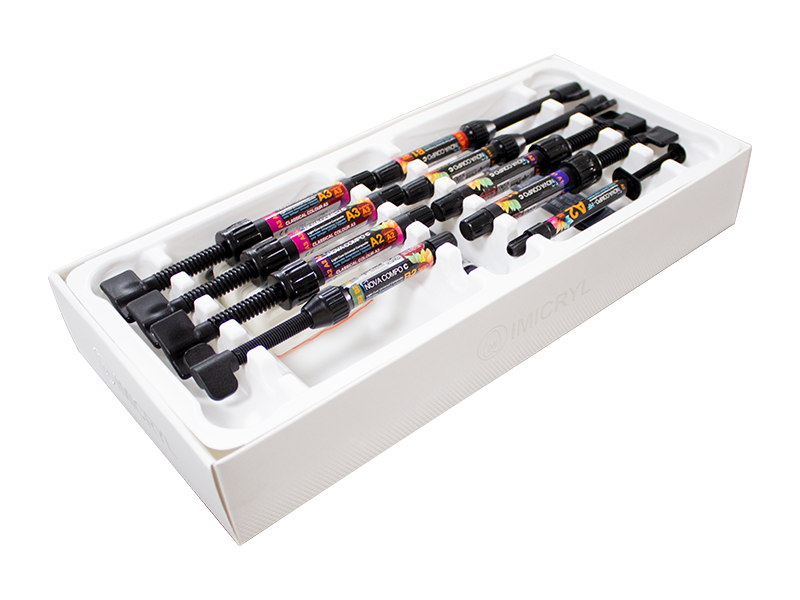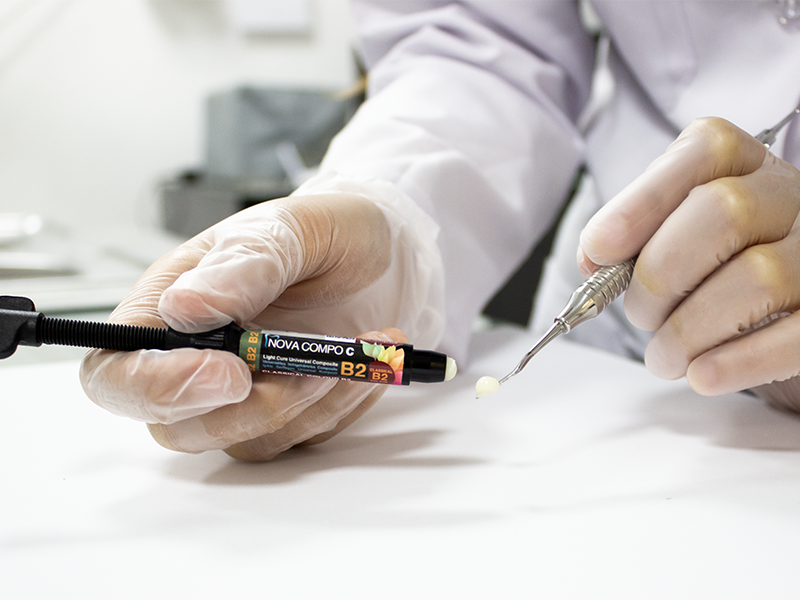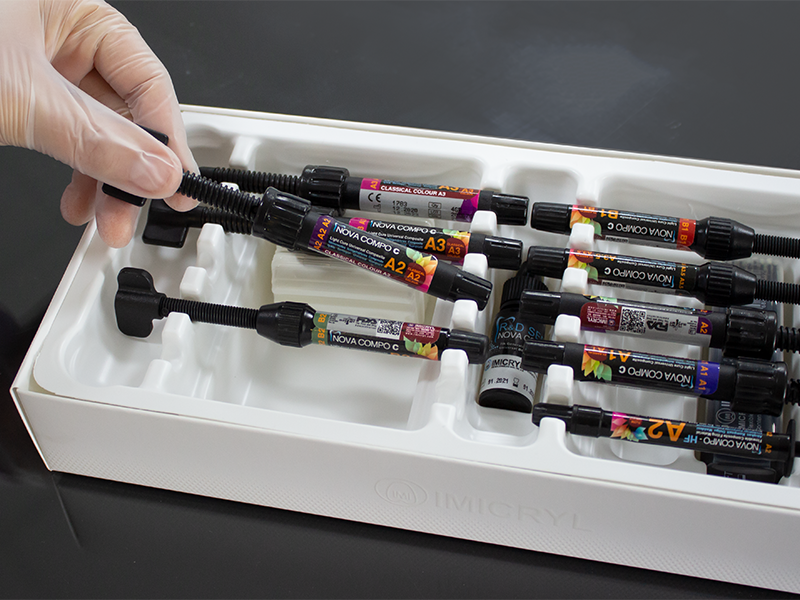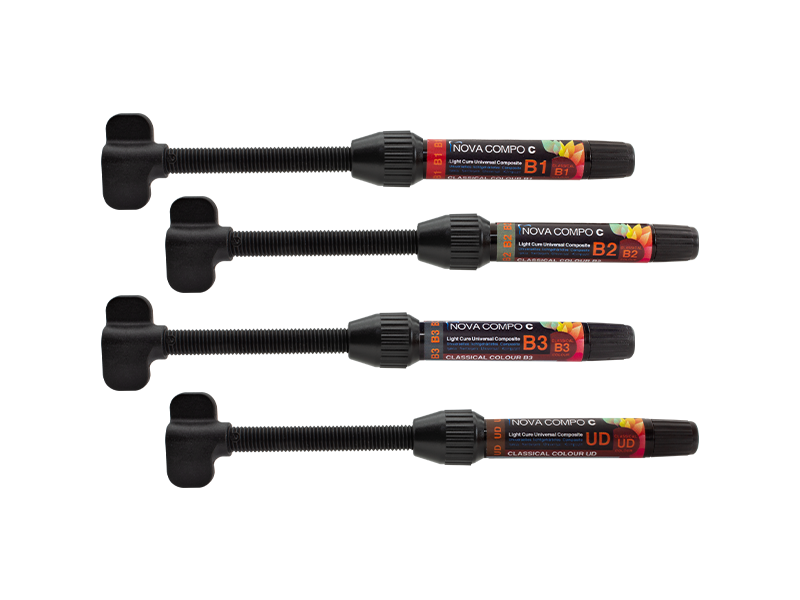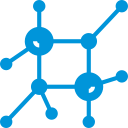Nova Compo C
Nano Hybrid Universal Composite
Nova Compo C is a light-curing, radiopaque, nano-hybrid composite for anterior and posterior restorations.
Composition
The monomer matrix is composed of different dimethacrylates (18–22% weight)and ULS® (Ultra Low Syhrinkage)Monomer . The fillers contain barium glasses, ytterbium and prepolymer (83–78 % weight), additives, catalysts, stabilizers and pigments.
Monomer Technology
Compo C is designed with the high molecular weight reduced shrinkage resins. The higher molecular weight of the resin results in less shrinkage, reduced aging and a slightly softer flexible resin matrix. Additionally these resins impart a greater hydrophobicity and are less water absorption. Nova Compo C contains very small amount of diluent monomers like TEGDMA. The diluent monomers have low molecular weight and high crosslinking capability, thus resulting in high elastic modulus and stiffness of the composite. Ideally composite restorations should not have high modulus of elasticity. The high modulus of elasticity composites are stiff, brittle materials and are not efficient in buffering high stress. The Modulus of Elasticity is optimised for Nova Compo C. Low molecular weight monomers increase the volumetric shrinkage and shrinkage stress of the composite.
Filler Technology
Nova Compo C is designed with different types, sizes and concentrations of fillers to determine the optimum translucency, strength, and radiopacity.
High density, radiopaque prepolymerized filler
0,7 micron ba-glass
0,4 micron ba-glass
Nano fillers
Prepolymerized fillers provide low shyrinkage, low stress, non-sticky, easy handling and shaping formulation. High loading Prepolymerized fillers provide better wear resistance than traditional less loaded Prepolymerized fillers in the marketing composites. In nano hybrid composite Compo C ; the spaces between the prepolymerized filler particles are occupied by nano fillers and different particle size ba-glasses. The nano fillers and 0,4 micron ba-glasses provide high polish, high wear, surface hardness and making the material smooth.
Compo C offers sufficient working time without premature setting of the material under the operatory light. The refractive index of the filler and matrix are optimised for the chameleon effect. Fillers with different optical properties were chosen for light transmission and scattering similar to the natural tooth structure (a better chameleon effect).
ULS MONOMER
ULS® monomer has high molecular weight, contains low C=C double bond and high flexibility. In this way, ULS® monomer reduces polymerization shrinkage and shrinkage stress.
ULS® monomer also has higher degree of convertion than traditional UDMA, Bis-GMA monomers. So it reduces residual monomer release and increases biocompatibility of composites.
ULS® monomer enhances high percent elongation and toughness to improve the durability of restorations. In high stress regions, the composite can tolerate the forces at the composite-tooth interface by showing some stretching and elongation.
Evaluation Of ULS® Monomer As An Additive
To evaluate ULS® monomer use as an additive, ULS® monomer was added in 10 wt% and 25 wt% to a 70:30 wt% blend of BisGMA and TEGDMA. Camphorquinone (CQ, 0.3 wt%, Sigma Aldrich.) and ethyl 4-dimethylaminobenzoate (EDAB, 0.8 wt%, Sigma Aldrich) system for this round of testing. The samples were prepaired according to ISO 4049 with a sizes of 25x2x2 mm. The specimens were tested in universal testing machine (DEVOTRANS-İstanbul-Turkey) by a 1 mm/ dk speed.
Degree Of Conversion For The ULS® Monomer
The average degree of conversion for the ULS® MONOMER was 32% higher than a BisGMA/TEGDMA (70/30) blend with an identical photoinitiator package and curing protocol. Camphorquinone (CQ, 0.3 wt%, Sigma Aldrich.) and ethyl 4-dimethylaminobenzoate (EDAB, 0.8 wt%, Sigma Aldrich) were used as the visible light (470 nm) photoinitiator system. After the spectrum of the uncured resin was obtained, the same specimen was photo-cured using a conventional dental light-curing unit by applying a 20-second exposure at a tip-to-resin distance of 2 mm. Five minutes after deactivation of light exposure, another infrared spectrum was obtained of the polymerized material. The resin was not removed from the ATR element during the process. The area ratios were then converted into degree of conversion data using methods common in the dental literature. [1, 2]
Comparison Of ULS® Monomer With Udma And Bis-GMA
As a result, the average value of shrinkage and shrinkage stress will decrease and the degree of polymerization will increase, although the mechanical properties and elastic modulus not damaged with added around 25% ULS® Monomer. Thanks to the high percent elongation and toughness value of the ULS® Monomer, the composite can tolerate the forces, especially in composite-tooth interfaces, by showing some stretching and elongation in high stress regions. In this way, long-lasting restorations can be obtained with ULS® Monomer.
Extended Longetivity and Durability
Excellent handling and Easy Polishability
No sticking to instruments.
Low polymerisation syrinkage and stress.
High radiopacity
Excellent wear resistance and high mechanical proporties
Suitability for mono layer and multi layer technique
Good chamelon proporties, Superior Aesthetics
Wide range of colour
Restorations of deciduous teeth
Restorations in the posterior region (classes I and II)
Anterior restorations (classes III, IV)
Class V restorations (cervical caries, root erosion, wedge–shaped defects)
Extended fissure sealing in molars and premolars
Splinting of mobile teeth
Veneering of discoloured anterior teeth and Repair of composite and ceramic veneers
2043 : 4 g Syringe
2049 : 5 g Syringe
2045 : 8 x 4 g Syringe / 1 x 5 ml Self Etch 7th Generation All in One MDP containing Acid Free Bonding / 2 g Nova Compo HF Flowable Composite / 50 x Bonding Application Brush Tips / 10 x Angled Black Application Tips /
25 x Double Bonding Application Platform
2044 : 8 x 4 g Syringe / 1 x 5 ml Self Etch Acid-Free Bonding with 7th Generation All in One MDP /
5 x 0.25 g Nova Compomer Rainbow Capsules in different colors / 2 g Nova Compo HF Aadhesive Composite 3 ml acid gel / 50 x Bonding Application Brush Tip / 25 x Double Bonding Application Platform / 25 x Bondnig Application Brush Tip / 1 x Application Brush / 1 x Spatula /
4 x Fine Polishing Disc Assortment / 4 x Medium Polishing Disc Assortment / 4 x Thick Polishing Disc Assortment / 10 blue Applicator /
10 black applicator / 1 x polishing disc chuck
2046 : 4 x 4 g Syringe / 1 x 5 ml Self Etch Acid-Free Bonding with 7th Generation All in One MDP / 50 x Bonding Application Brush Tip / 25 x Double Bonding Application Platform


